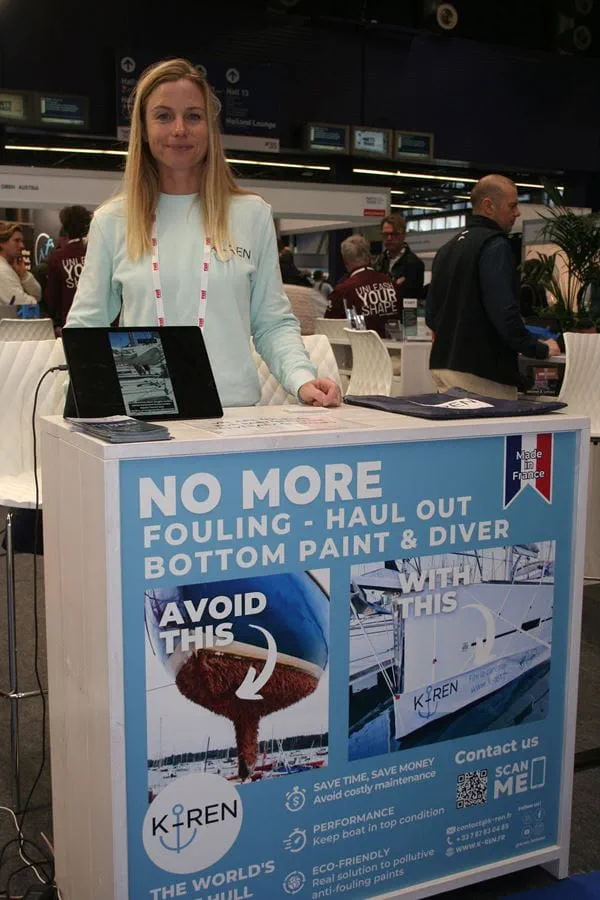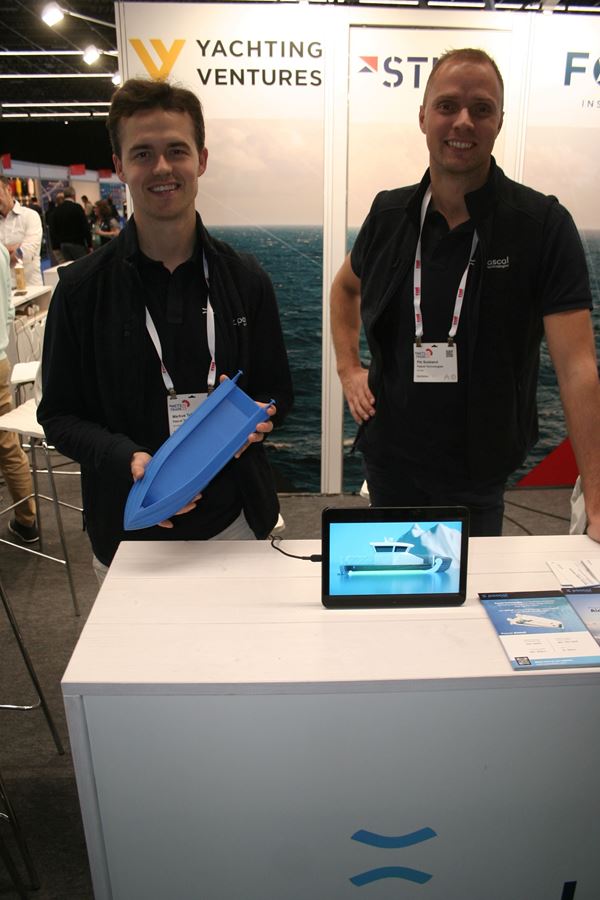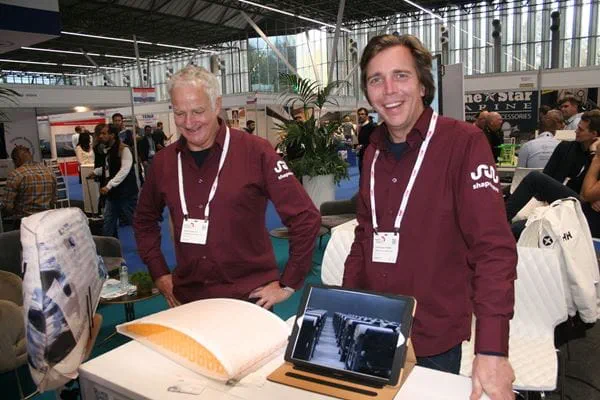Young inventors, ready to share their bright ideas with the world marine community, present their start-up businesses at the Start-Up Pavilion (STP) at METSTRADE 2023. Fifteen recently founded companies together made the pavilion, that was organised by Yachting Ventures, an investor company that helps start-ups in the marine industry.
STP is new for this year. Participators have been invited by Yachting Ventures. Founder and CEO Gabriellle Richardson explains that especially at METSTRADE, where the world marine industry comes together, a great opportunity opens for these companies to connect to the sector. Companies in the marine industry are quite interested in new products to improve their services and make these more sustainable. As with a lot of new inventions, the drive to do things more durable is a key element in marine innovation.
A first impression of STP comes from an introduction to three out of the fifteen participants, randomly chosen and still representative.
K-REN
“We are progressing into phase two with our start-up company K-REN,” Lucie Doriez says at her mini booth at the Start-Up Pavilion (STP) during the METSTRADE show. “We started the company in 2021, sold a couple of hundreds of our fouling protecting underwater boat covers and really wanted to come to this show. But we were hesitant. The organizers approached us and invited us to take part in the STP. After the first years, we have established an initial network of partners that serve as pick-up points for our clients, who are individual boat owners.” K-REN nowadays works with eight partners along the French Mediterranean coast, six along the Atlantic coast and south coast of Brittany, five along the Channel of Calais and one in Belgium. Internationally, there are pick-up points in Martinique and Guadeloupe in the Caribbean Sea as well as Papeete and New Caledonia in the Pacific. “It is only a small network today, but it is spread around the globe, Doriez affirms. “We focus on the warmer areas first. In warm waters, the fouling grows quickest. We are aiming to open a distribution point in the United States, soon.”
The K-REN product is an underwater cover that is pulled under a yacht when it is docked in its berth. The cover, made from carbon-neutral and recyclable cloth, blocks light to shine in the water around the hull, In the dark, fouling will not grow. It is as simple as that. No biocides or other toxic material is needed. When the boat is moving, no antifouling will attach to the bottom. “Even the small underwater plants and animals that have attached to the hull during a holiday or when the boat was at anchor, will die and release from the hull once the underwater cover is put back around the hull, as they will not survive in complete dark,” Doriez ensures. The underwater covers are custom-made for every boat. Weights help the skippers to get the fabric under the hull and keel. Lines to the clamps on the deck tighten the cover around the bottom. Installation should take about 15 minutes. With no need for antifouling paint, the smoothest surface of the underwater hull can be applied for smooth sailing. “My father had the idea that blocking light from the water around the hull should prevent fouling form growing onto the boat.” Doriez says. “He made a cover for his own boat in 2004 and tested it thoroughly. It works. Even fouling that is already on the hull, will release once you start using K-REN. We want to stop toxic releases from antifouling into the water.”
 Lucie Doriez introduces the K-REN fouling protection cover to the world marine industry at the STP at METSTRADE 2023
Lucie Doriez introduces the K-REN fouling protection cover to the world marine industry at the STP at METSTRADE 2023
Pascal Technologies
“We can make powerboats go fast while using half the energy needed for propulsion at higher speeds,” Markus Tufte-Johnsen assures. At the booth of Pascal Technologies at the STP, he shows a 30 centimetre long model of a speedboat of which the V-shape under the bottom seems to be missing. “The Pascal Air Hull creates a cushion of air under the hull that reduces drag significantly. The exact savings in drag will be different for each boat, but once the boat reaches planing speed, drag will reduce by about fifty percent.” This reduces energy consumption and thus fuel consumption and the emissions from the exhaust pipe related. “It also offers another option for electric propulsion to extend the range and reach higher speeds, for those boaters that do not want to fly on hydrofoils,” Tufte-Johnsen remarks. An electric powered fan blows air through a tube through the bow, from the deck down to the forward part of the underwater hull, The V-shapp of the planing hull stops a short length behind the bow, where a large hollow form makes the larger part of the underwater hull, with the sides of the hull being deeper. The air cushion is captured between the bow, the side parts of the hull and a trim flap at the stern. At lower speeds, a Pascal Air Hull will behave the same as any speedboat. At higher speed, it will go over the water more smoothly and show less backward trim. In tight curves, the air cushion may deflate as the sides of the boat come above the water. As soon as the boat steers straight again, the cushion will be pumped back right under the boat. Using Pascal Air Hull technology, the Ripple Boats brand was established in 2023. Together with Nimbus Group, an aluminium concept boat was built using the electric outboard from Evoy in the Alukin brand. A crew transfer vessel for aquaculture is developed to bring the workers to the large amounts of fish farms in the Norwegian Fjords. “Our company started in 2019, but is based on more than 15 years of hydrodynamic research,” Tufte-Johnsen says. “Since an investor bought the research company Effect Ship International, we have been making a boating product out of their research. We are happy to present this at the STP.”
 CFO Markus Tufte-Johnsen (left) and Head of Sales Christian Wallin (right) from Pascal Technologies present the Pacal Air Hulll at STP at METSTRADE 2023.
CFO Markus Tufte-Johnsen (left) and Head of Sales Christian Wallin (right) from Pascal Technologies present the Pacal Air Hulll at STP at METSTRADE 2023.
Shapewave Industries
“With our technology, we can make inflatable structures in all kinds of different shapes, with curves and hollow parts,” Dominique Kwaks, co-founder of Shapewave Industries explains. “We create a webbing inside inflatable structures that can vary in length, to create all kinds of shapes and allow the inflatable to be pumped quite hard, so a reasonably strong structure will be the result. Our technology could very well be used to create inflatable wing sails. One of our sponsors in DNA composites, creators of the foiling A-Cat. Both me and co-founder Rudo Enserink are keen sailors. The technology that we patented in 2018, is compared to the drop stitch technology that is used in inflatable SUP boards by a lot of people who see it for the first time. Shapewave is more refined: it allows to create far more extreme and customized shapes with the inflatables. At the moment, we are creating the first machine to make the welded tape technology. We have written software and are engineering the machine and its parts. We started our company late 2022, so we are up for our first birthday. When we received a call from Yachting Ventures, the organizer of the STP, we were quite happy to be invited to take part in the STP here at METSTRADE 2023.”
 Rudo Enserink (right) and Dominique Kwaks (left) with a sample of their welded tape technology inflatable.
Rudo Enserink (right) and Dominique Kwaks (left) with a sample of their welded tape technology inflatable.













